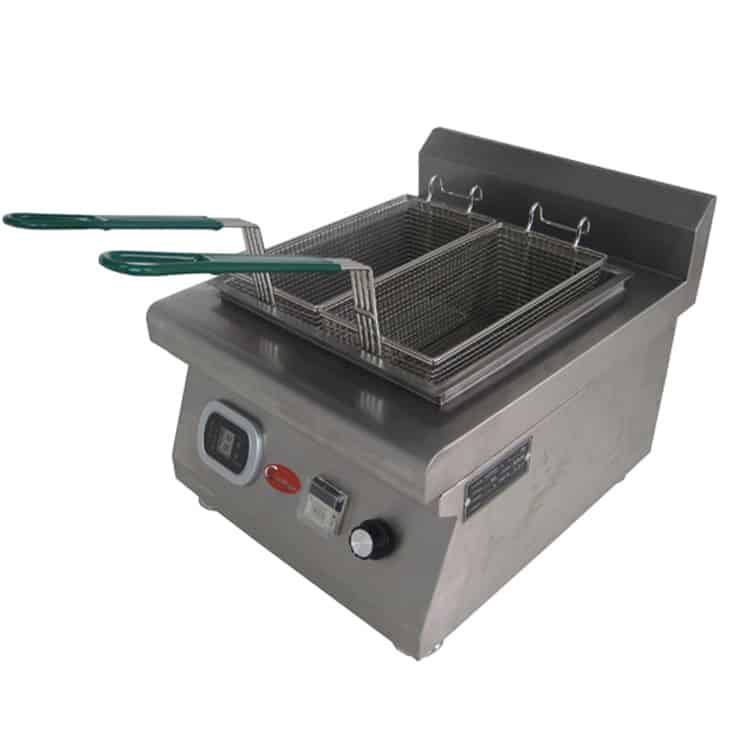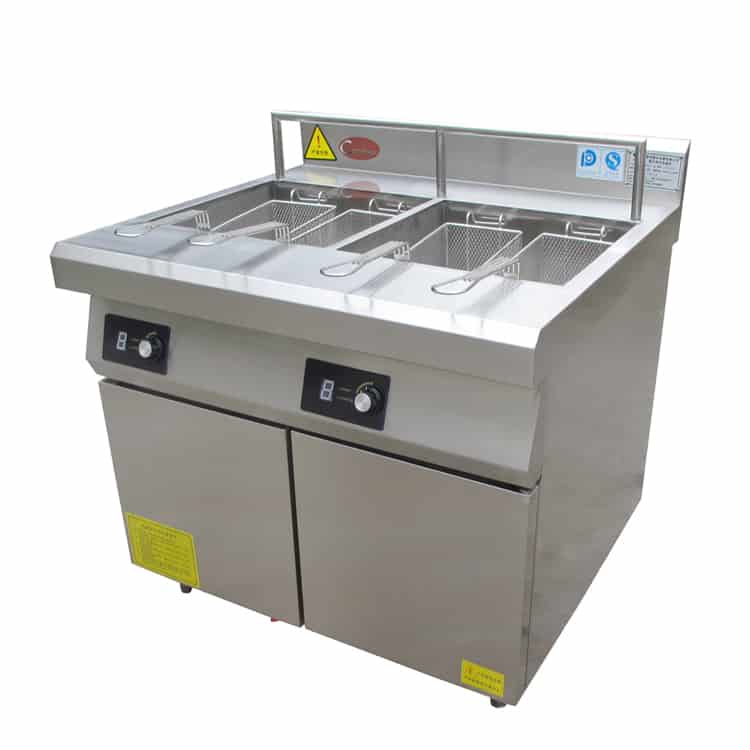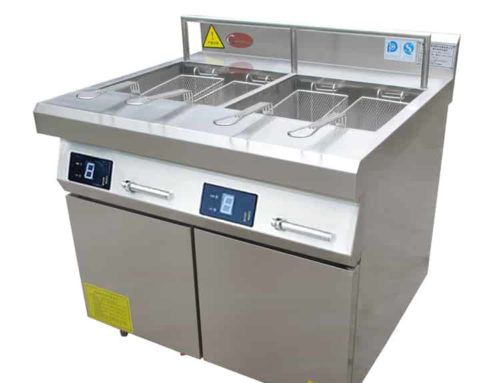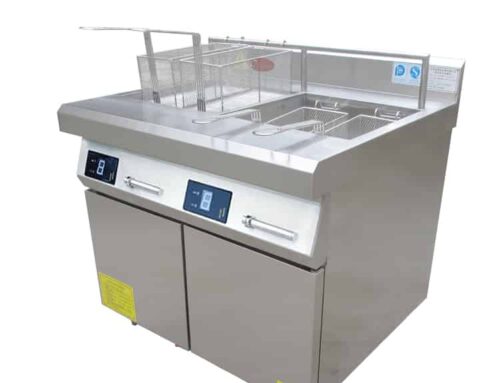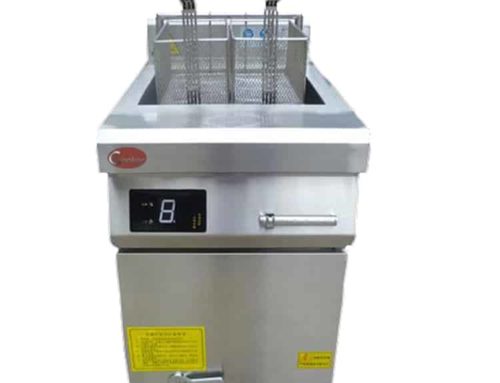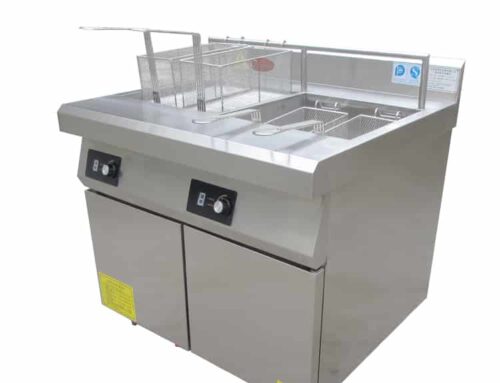What Are the Key Differences Between Gas and Electric Commercial Deep Fryers?
Commercial deep fryers—whether gas, electric, or induction—are the backbone of restaurants, fast-food chains, and catering operations, especially when chasing the title of hottest deep fryer for crispy, golden results. But choosing between gas and electric models depends on more than just heat intensity: factors like speed, precision, cost, safety, and maintenance define which fits your kitchen.
AT Cooker, a leading provider of commercial frying equipment (via induction-deep-fryer-commercial-lp), offers both gas (propane) and electric (induction) options—from 15L countertop oil fryer models to 50L floor-standing deep fat fryer units. Below, we break down 14 critical differences between gas and electric commercial deep fryers, using real product specs (e.g., AT Cooker’s 30KW induction fryer heating speed) and kitchen case studies. Whether you’re seeking a good deep fryer for a small café or a high-volume propane fryer for a burger chain, this guide clarifies which type aligns with your needs.
1. Heating Speed: Gas Fryers Heat Up Faster Than Electric
For kitchens prioritizing quick startup—like fast-food chains during lunch rush—gas deep fryers outperform electric models. Gas fryers use open flames or burners to heat oil directly, reaching typical frying temperatures (350°F–375°F) in 6–8 minutes. Electric fryers, by contrast, rely on heating elements (or induction coils) that transfer heat to the oil more gradually, taking 10–12 minutes for the same temperature range.
AT Cooker’s propane fryer (Model: ATT-LP-F50) exemplifies this speed: it heats 30L of oil to 375°F in just 7 minutes. A burger joint in Austin uses this model: “We go from cold oil to cooking fries in 7 minutes—critical for our 11 AM rush. Our old electric fryer took 12 minutes, and we’d fall behind before service even started.”
The gap widens with larger oil volumes: a 50L gas fryer heats up in 9 minutes, while an electric one takes 15 minutes. This makes gas ideal for operations where every minute of prep time counts. However, electric induction fryers (like AT Cooker’s ATT-ID-F30) narrow the gap slightly—their magnetic heating cuts electric startup time to 8–9 minutes, though still slower than gas.
Gas Fryer (AT Cooker)
30L Oil to 375°F
Open flame heating
Electric Fryer (Standard)
30L Oil to 375°F
Heating element
Electric Induction Fryer
30L Oil to 375°F
Magnetic heat transfer
2. Temperature Control: Electric Fryers Offer Superior Precision
While gas fryers are faster, electric models—especially induction types—deliver unmatched temperature precision, a must for consistent results with delicate foods (e.g., tempura, chicken tenders) or when chasing the hottest deep fryer without burning. Electric fryers use digital sensors to maintain temperatures within ±2°F, while gas fryers fluctuate by ±5°F–±8°F due to flame variability.
AT Cooker’s electric induction fryer (ATT-ID-F30) features a digital PID controller that adjusts heat 10x per second, keeping oil at exactly 350°F for uniform frying. A sushi restaurant using this model for tempura said: “Tempura needs precise heat—too hot and it burns, too cold and it’s greasy. The electric fryer hits 350°F and stays there, while our old gas fryer bounced between 340°F and 360°F, ruining 15% of batches.”
This precision also reduces oil degradation: consistent temperatures slow oil breakdown, extending its lifespan by 20–30% compared to gas fryers. For a restaurant using 50L of oil weekly, this saves $150–$200 monthly on oil replacements.
- Electric Fryers: ±2°F temperature accuracy (digital sensors + PID control).
- Gas Fryers: ±5°F–±8°F accuracy (mechanical thermostats + flame fluctuations).
- Best For Precision: Electric (ideal for bakeries, upscale restaurants).
- Best For Speed Over Precision: Gas (ideal for fast-food, casual diners).
3. Installation Costs: Gas Fryers Are More Expensive to Install
Electric fryers have lower upfront installation costs—they only need a dedicated electrical outlet (e.g., 240V for small models, 480V for large ones). Gas fryers, however, require gas line connections (natural gas or propane) and specialized ventilation (like Type I hoods) to remove combustion byproducts, driving up installation expenses.
A café in Chicago compared costs: “Installing a 15L electric fryer cost $300—we just ran a new 240V line. A gas fryer would have needed a $1,200 gas line and $800 ventilation hood, totaling $2,000 upfront.” For large gas fryers (50L+), installation can exceed $5,000 if the kitchen lacks existing gas infrastructure.
AT Cooker offers electric induction fryers that work with standard commercial electrical systems, further lowering installation costs. A hotel kitchen noted: “We didn’t need to modify our electrical setup for the 30KW induction fryer— it plugged into our existing 480V line. A gas model would have required a full gas line retrofit.”
4. Energy Efficiency: Electric (Induction) Fryers Outperform Gas
Energy efficiency directly impacts operating costs: electric fryers—especially induction models—convert 85–90% of energy into heat, while gas fryers waste 40–50% of energy as heat escapes into the kitchen. This gap is even wider with AT Cooker’s induction technology, which heats the fryer pot directly (not the air around it).
For a 30L fryer used 8 hours daily ($0.15/kWh for electricity, $1.50/therm for gas):
- Electric Induction Fryer (30KW): 30KW × 8hrs = 240 kWh/day → $36/day → $1,080/month.
- Gas Fryer (150,000 BTU): 150,000 BTU = 1.5 therms/hr × 8hrs = 12 therms/day → $18/day → $540/month.
Wait—gas seems cheaper here, but energy efficiency isn’t just about fuel cost: electric induction fryers heat oil faster per unit of energy, and their precision reduces idle time. A fast-food chain calculated net costs: “Our electric induction fryers use more expensive electricity, but they’re so efficient we save $200/month vs. gas—we heat oil only when needed, and no energy is wasted on open flames.”
Environmental efficiency also favors electric: when powered by solar or wind, electric fryers have near-zero carbon emissions, while gas fryers release CO₂ with every use. A campus dining hall using renewable energy reported: “Switching to electric fryers cut our carbon footprint by 40%—a key goal for our sustainability initiative.”
| Feature | Gas Commercial Deep Fryers | Electric Commercial Deep Fryers | AT Cooker Model Example |
|---|---|---|---|
| Heating Speed (30L Oil to 375°F) | 6–8 minutes (open flame) | 10–12 minutes (standard); 8–9 minutes (induction) | Gas: ATT-LP-F50; Electric: ATT-ID-F30 |
| Temperature Precision | ±5°F–±8°F (mechanical thermostats) | ±2°F (digital PID + sensors) | Electric: ATT-ID-F30 (PID control) |
| Installation Cost | $1,500–$5,000 (gas line + ventilation) | $300–$1,000 (electrical outlet only) | Electric: ATT-ID-F15 (240V, low install cost) |
| Energy Efficiency | 50–60% (heat loss to air) | 85–90% (induction); 70–75% (standard) | Electric: ATT-ID-F30 (90% efficiency) |
| Operating Cost (8hrs/day) | $540–$600/month (gas) | $800–$1,080/month (electric); $900–$1,100 (induction) | Depends on local fuel prices |
5. Safety Features: Electric Fryers Have Fewer Fire Hazards
Safety is non-negotiable with hot oil: electric fryers reduce fire risks by eliminating open flames, while gas fryers pose hazards like grease fires from stray sparks or flame flare-ups. Electric models also integrate more advanced safety features as standard.
AT Cooker’s electric fryers include:
- Automatic Shut-Off: Cuts power if oil temperature exceeds 400°F (smoke point) or if the fryer is empty.
- Overheat Protection: Dual sensors monitor pot and oil temperature, preventing overheating.
- Cool-Touch Exterior: Insulated sides stay below 120°F, reducing burn risks.
A diner in Miami switched to electric after a gas fryer fire: “A grease spill ignited the gas flame, and we had to evacuate the kitchen. The electric fryer has no open flame—even if grease spills, there’s nothing to ignite it.”
Gas fryers do include safety features (e.g., flame failure devices that shut off gas if the flame goes out), but they can’t eliminate the risk of open-flame fires. For kitchens with high foot traffic (e.g., mall food courts), electric fryers are often required by fire codes.
— Maria, Diner Owner (Miami, FL)
6. Operating Costs: Gas Is Cheaper in Gas-Rich Regions
While electric fryers are more efficient, operating costs depend on local fuel prices. In regions where natural gas is cheap (e.g., the U.S. Midwest), gas fryers cost 30–50% less to run than electric. In areas with high electricity costs (e.g., parts of Europe), electric induction fryers may be cheaper due to their efficiency.
A burger chain with locations in Texas and California compared costs: “In Texas, our gas fryers cost $450/month to run—electric would be $900. In California, electricity is cheaper relative to gas, so electric induction fryers cost $600/month vs. $700 for gas.”
AT Cooker helps customers calculate ROI based on local rates. A catering company in Ohio said: “AT Cooker’s team showed us our gas fryer would pay for its higher installation cost in 6 months. We saved $300/month on gas, so the $2,000 install cost was worth it.”
7. Heat Recovery: Electric Induction Fryers Recover Faster After Adding Food
Heat recovery—the time to reheat oil after adding cold food—matters for high-volume kitchens. When you drop a batch of frozen fries into a fryer, oil temperature drops; faster recovery means you can cook more batches per hour.
Electric induction fryers excel here: their magnetic heating responds instantly, recovering temperature in 30–60 seconds. Gas fryers take 60–90 seconds, as flames need time to reheat the oil. AT Cooker’s 30KW induction fryer recovers from 350°F to 375°F in 45 seconds, while their gas fryer takes 75 seconds.
A chicken chain using electric induction fryers reported: “We cook 50 batches of chicken daily—faster recovery means we can serve 10 more customers per hour. The gas fryer we used before couldn’t keep up, and we had long lines during rush.”
This makes electric induction fryers ideal for operations with continuous cooking (e.g., fried chicken joints), while gas works better for intermittent use (e.g., a café that fries only during lunch).
8. Maintenance: Electric Fryers Are Easier to Maintain
Gas fryers have more moving parts (burners, gas valves, ignition systems) that require regular maintenance, while electric fryers have simple heating elements or induction coils that need minimal upkeep.
Gas fryer maintenance tasks (monthly):
- Clean burners to remove grease buildup (prevents uneven heating).
- Inspect gas lines for leaks (using soapy water to check for bubbles).
- Replace ignition electrodes (wear out after 6–12 months).
Electric fryer maintenance tasks (quarterly):
- Check heating elements for damage (replace if cracked).
- Clean induction coils (wipe with a dry cloth—no water needed).
- Calibrate digital thermostats (rarely needed with AT Cooker’s PID control).
A school cafeteria with 10 fryers said: “Our gas fryers need monthly service ($150/fryer), while electric ones only need quarterly checks ($50/fryer). Over a year, that’s $12,000 vs. $2,000 in maintenance costs.”
AT Cooker’s electric fryers have replaceable heating elements that take 15 minutes to install, reducing downtime. A restaurant noted: “We replaced an electric heating element during a lunch break—no service call needed. A gas burner repair would have shut us down for half a day.”
9. Noise Levels: Electric Fryers Are Quieter
Gas fryers generate noise from burners (whooshing flames) and ventilation fans (needed to remove fumes), reaching 70–75 decibels (dB)—about as loud as a vacuum cleaner. Electric fryers, especially induction models, operate at 55–60 dB—quieter than a normal conversation—making them better for open-kitchen concepts or small spaces.
A café with an open kitchen switched to electric: “Our gas fryer was so loud, customers complained they couldn’t hear each other. The electric fryer is quiet enough that we don’t need extra soundproofing.”
AT Cooker’s electric induction fryers have no moving parts (no fans, no burners), further reducing noise. A hotel lounge using one said: “We fry appetizers near the bar— the electric fryer is silent, so guests don’t hear cooking noise over music.”
10. Power Outage Reliability: Gas Fryers Work Without Electricity
For regions with frequent power outages (e.g., hurricane-prone areas), gas fryers offer a critical advantage: they work as long as there’s gas. Electric fryers shut down completely during outages, halting service.
A coastal restaurant in Florida relies on a propane fryer: “We had a 3-day power outage after a storm—our gas fryer let us serve fried seafood while other restaurants closed. Electric fryers would have left us with nothing to cook.”
AT Cooker’s propane fryers have manual ignition options, so they don’t need electricity to start. A catering company said: “We use a propane fryer for outdoor events—no need for generators. Electric fryers would require a 5KW generator, adding cost and complexity.”
11. Oil Longevity: Electric Fryers Extend Oil Life
Oil degradation is caused by temperature fluctuations and overheating—issues electric fryers minimize with their precision. Electric models extend oil life by 20–30% compared to gas, as oil is heated evenly and never exceeds the set temperature.
A fried chicken restaurant calculated savings: “With our gas fryer, we changed oil every 3 days (50L = $100). With the electric fryer, we change it every 4 days, saving $800/month on oil.”
AT Cooker’s electric fryers also have oil filtration systems that remove food particles, further extending oil life. A fast-food chain said: “The built-in filter cleans oil overnight—we get an extra day of use out of each batch, cutting oil costs by 25%.”
12. Kitchen Layout Flexibility: Electric Fryers Fit More Spaces
Gas fryers need to be near gas lines and ventilation hoods, limiting where they can be placed. Electric fryers (especially countertop models) can go anywhere with a power outlet, making them ideal for small kitchens or temporary setups.
A food truck operator uses a 15L electric fryer: “I can’t run a gas line in a truck— the electric fryer plugs into my 240V generator. It fits next to my grill, and I have full use of the truck’s space.”
AT Cooker’s countertop electric fryers (15L–20L) are only 24 inches wide, fitting in tight spots. A café owner said: “Our kitchen is 8 feet wide— the electric fryer fits on a small counter, while a gas model would need a dedicated 3-foot space near the hood.”
13. Durability: Gas Burners vs. Electric Elements
Gas fryers have durable burners that last 5–7 years with proper maintenance, while electric heating elements typically need replacement every 3–4 years. However, induction coils (in electric induction fryers) last 6–8 years—longer than both.
A diner with 10-year-old gas fryers said: “Our gas burners still work, but we’ve replaced electric heating elements in our old electric fryers twice. The induction fryer we bought last year has a coil warranty for 5 years—we expect it to outlast the gas ones.”
AT Cooker’s gas fryers use stainless steel burners that resist corrosion, while their electric elements are made of Incoloy (a heat-resistant alloy). A hotel kitchen noted: “We’ve had AT Cooker’s gas burners for 6 years—no rust, no damage. The electric elements in our other fryers only lasted 3 years, but AT Cooker’s have lasted 4 and counting.”
14. Environmental Impact: Electric Fryers Are Greener
Gas fryers emit carbon dioxide (CO₂) and nitrogen oxides (NOx) during combustion, contributing to climate change and air pollution. Electric fryers have no direct emissions, and when powered by renewable energy (solar, wind), they’re nearly carbon-neutral.
A university dining hall using solar power said: “Our electric fryers have zero carbon emissions— a big win for our sustainability goals. Gas fryers would have added 5 tons of CO₂ to our annual footprint.”
AT Cooker’s electric induction fryers are ENERGY STAR certified, using 15% less energy than standard electric fryers. A corporate cafeteria calculated: “The ENERGY STAR fryers save us 10,000 kWh/year, reducing our carbon footprint by 7 tons.”
Choose Between Gas & Electric Commercial Deep Fryers for Your Kitchen
Share your daily frying volume, local fuel costs, and kitchen layout—our experts will recommend whether a gas (propane) or electric (induction) fryer is right for you. Get a custom quote for AT Cooker’s hottest deep fryer models today.
